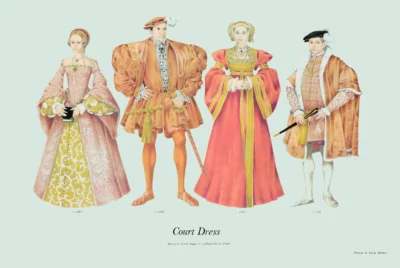Spanish Dress, 1550-1560
£7.50
Spanish Dress, 1550-1560 (scroll down for a more detailed Description)
Published 1968 by © Hugh Evelyn Limited; drawn by Faith Jaques
Size: c. 38 x 25.5 cm [15″ x 10″] may vary slightly from printers’ cut 50 years ago
Printed on medium cardstock weighing 151 g/sm2 faced in light greyish cyan – lime green (RGB: c. d8e8e0)
Print is STANDARD size – shipping is the same for 1 to 10 prints (based on largest print size in your order) – see Shipping & Returns.
In stock
Description
Despite warm climates and lack of hygiene, clothes became stiffer and more padded and heads held higher on rigid collars. Strong-willed women like Mary and Elizabeth held their own in a man’s world and aped a masculine style of dress, an expression of equality. Only after the novelty of power had worn a little was there a loosening of female costume. A new fashion drew in on shoulders, revers and sleeves. The prudery of the Spanish court filled in the open neckline of women’s dresses and stiffened the costume so much that face and hands were the only movable parts left. Corsets of metal strips gripped the ribs and pushed superfluous flesh down from the waist preventing bending. Skirts, cut in sections of shaped gores with no fold to spoil the cone-shape, were stiffened with heavy linen or canvas and metal or wooden hoops at the hems to hold them rigid, the first ‘farthingale’. The ropa of Spain is like the Schaube, which German women had worn for years. Christina of Denmark wears it Holbein’s 1538 portrait. The Hapsburgs introduced it to Spain. Some women shared men’s responsibilities resulting in a masculine trend in their costume. Bodices followed the lines of the doublet, square shoulders and high neck over which the points of a collar were turned down to frame the chin. Sleeves turned upside-down to emphasize the shoulderline. The French rendered the mantle a more feminine overdress, the old square, low neckline, above which the elaborate undergown showed as a yoke and again under the half-sleeves of the upper garment. Hair could show as hood gave place to cap and bonnet, with embroidered or jewelled bands, set well back on the head. Regional details of costume remained like the ‘˜ear-phone’ on the bonnet of the formidable Hapsburg Queen Regent of Portugal. For men the waistline was lowered, padded and pointed in front, the skirts of the jerkin shortened until they became an ornamental edging, sometimes in two layers of pointed tabs, repeating the edging of the shoulder and armholes. This finish was called piccadils (Italian picca, spear-head). Jerkin collars stood high, lifting the head on little frilled edges of the shirt, later to become the ruff. Doublet sleeves became close-fitting even if decorated with slashing which lay flat over material that was no longer puffed. Pouches worn on decorated belts also held the sword. Breeches were seen by the 1550s with the beginning of bombasting, or padding, that became pumpkin-like later. Upper-stocks were still made in two layers with short straps of heavy material over full ruffled linings joined to nether-stocks for comfort. The codpiece was becoming obsolete; fashion became less masculine. Hat crowns rose higher as breeches crept up the thigh, making a more elongated figure, decorated with ostrich feather curling round the brim, then finished with a rosette or jewel. The fancy ankle-boots of the Duke of Altri were part of a ceremonial costume but the short hair and trimmed beard saved the effect from appearing sissy.
Additional information
| Weight | 0.0147 kg |
|---|---|
| Dimensions | 38 × 25.5 cm |





